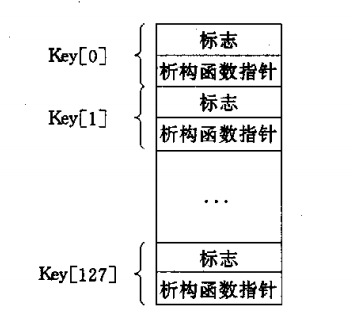线程的私有数据(TSD)
来源:互联网 发布:图片html源码怎么看 编辑:程序博客网 时间:2024/05/22 13:08
我们知道 一个进程内的所有线程继承其数据与环境变量,共享数据空间,但是有时候我们需要有的线程拥有独属于其自己的数据变量,让其只在某个线程内有效,比如最常见的errno,每个线程出错的原因大不相同。 这个时候就需要创建线程的私有数据(TSD)了
线程的私有数据可以被其他函数访问,但拒绝被其他线程屏蔽
TSD采用了一键多值的技术,即一个键对应多个不同的值,每个线程访问数据时通过访问该键来得到对应的数据,在不同的线程中它对应了不同的值
其实系统为每个进程维护了一个称之为Key结构的结构数组,如下图所示: 
(这里不介绍析构函数,图片来源网络)
如图,这个pthread_key_t(其实是unsigned int)类型的key,在进程中创建,一般为0~127
在上图中Key 结构的“标志”指示这个数据元素是否正在使用。在刚开始时所有的标志初始化为“不在使用”。当一个线程调用pthread_key_create创建一个新的线程特定数据元素时,系统会搜索Key结构数组,找出第一个“不在使用”的元素。并把该元素的索引(0~127)称为“键”。 返回给调用线程的正是这个索引
key一旦被创建,所有线程都可以访问它,但各线程可以根据自己的需要往key中填入不同的值,这就相当于提供了一个同名而不同值的全局变量,即一键多值
例:
#include<stdio.h>#include<string.h>#include<stdlib.h>#include<pthread.h>#include<unistd.h>pthread_key_t key;void *thread2( void *arg ){ int tsd = 5; printf( "thread2 %lu is running \n",pthread_self() ); pthread_setspecific( key,&tsd ); printf( "thread2 %lu returns %d\n",pthread_self(),*(int *)pthread_getspecific(key) );}void *thread1( void *arg ){ int tsd = 0; pthread_t thid2; printf( "thread1 %lu is running\n",pthread_self() ); pthread_setspecific( key,&tsd ); pthread_create( &thid2,NULL,thread2,NULL ); sleep( 3 ); printf( "thread1 %lu returns %d\n",pthread_self(),*(int *)pthread_getspecific(key) );}int main(){ pthread_t thid1; int statl; printf( "main thread begins running\n" ); pthread_key_create( &key,NULL ); pthread_create( &thid1,NULL,thread1,NULL ); sleep(5); pthread_key_delete(key); printf( "main thread exit\n" ); return 0;}运行结果为:
注:pthread_getspecific()函数返回的是与key相关联数据的指针,它是void类型的,虽然指向关联的数据地址处,但并不知道指向的数据类型,记得强转
阅读全文
0 0
- 线程的私有数据(TSD)
- 线程私有数据TSD
- 线程私有数据TSD
- 线程私有数据的介绍与使用(TSD)
- 线程的私有数据(TSD-Thread-Specific Data)
- 【多线程编程】线程私有数据(TSD)
- 实现一个线程安全的内存池(使用线程私有数据机制TSD来实现)
- SDK错误号的原理---线程私有数据(TSD)
- 线程私有数据(Thread-specific Data,或TSD)
- Thread-Specific Data(TSD)线程私有数据
- 线程特定数据(TSD)
- linux 线程私有数据之一键多值技术TSD池
- linux线程私有数据之一键多值技术TSD池
- 线程私有数据TSD——一键多值技术,线程同步中的互斥锁和条件变量
- 线程特定数据TSD总结
- 12.线程特定数据TSD
- 线程的基本属性(分离,栈大小,保护区,竞争,调度并发)以及TSD特定数据
- 多线程编程之私有数据(Thread-Specific-Data,或TSD)
- TortoiseGit 2.5.0 正式发布,Git 客户端
- SpringBoot-WebSocket广播消息+单点消息(指定用户发送消息)
- mysql分表和表分区详解
- Python之拷贝对象
- 百练2792:集合加法
- 线程的私有数据(TSD)
- 设计模式C++实现(11)——装饰模式
- Android开发 sharesdk分享微信/朋友圈的时候只显示文字,不显示链接
- C/C++实现strcpy和strcat两个功能
- Java多线程的两种实际应用
- android中捕获全局异常
- poj 2409 Let it Bead(polya)
- VMware虚拟机过卡-解决办法(Win10系统)
- 关系型数据库与非关系型数据库的区别?



